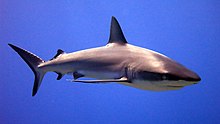
Back Yèe ACE Haaie Afrikaans Haie ALS ድንገተኛ አሣ Amharic Selachimorpha AN Sǣhund ANG قرش (سمكة) Arabic روكان ARY قرش ARZ হাংগৰ Assamese
| Sharks Temporal range: Possible records extend back to Early Permian
| |
|---|---|

| |
| A grey reef shark (Carcharhinus amblyrhynchos) | |
| Scientific classification | |
| Domain: | Eukaryota |
| Kingdom: | Animalia |
| Phylum: | Chordata |
| Class: | Chondrichthyes |
| Subclass: | Elasmobranchii |
| Infraclass: | Euselachii |
| Clade: | Neoselachii |
| Subdivision: | Selachimorpha Nelson, 1984 |
| Orders | |
| Synonyms | |
| |
Sharks are a group of elasmobranch fish characterized by a cartilaginous skeleton, five to seven gill slits on the sides of the head, and pectoral fins that are not fused to the head. Modern sharks are classified within the clade Selachimorpha (or Selachii) and are the sister group to the Batoidea (rays and kin). Some sources extend the term "shark" as an informal category including extinct members of Chondrichthyes (cartilaginous fish) with a shark-like morphology, such as hybodonts. Shark-like chondrichthyans such as Cladoselache and Doliodus first appeared in the Devonian Period (419–359 million years), though some fossilized chondrichthyan-like scales are as old as the Late Ordovician (458–444 million years ago).[1] The oldest confirmed modern sharks (selachimorphs) are known from the Early Jurassic, about 200 million years ago, though records of true sharks may extend back as far as the Permian.
Sharks range in size from the small dwarf lanternshark (Etmopterus perryi), a deep sea species that is only 17 centimetres (6.7 in) in length, to the whale shark (Rhincodon typus), the largest fish in the world, which reaches approximately 12 metres (40 ft) in length.[2] They are found in all seas and are common to depths up to 2,000 metres (6,600 ft). They generally do not live in freshwater, although there are a few known exceptions, such as the bull shark and the river shark, which can be found in both seawater and freshwater.[3] Sharks have a covering of dermal denticles that protects their skin from damage and parasites in addition to improving their fluid dynamics. They have numerous sets of replaceable teeth.[4]
Several species are apex predators, which are organisms that are at the top of their food chain. Select examples include the tiger shark, blue shark, great white shark, mako shark, thresher shark, and hammerhead shark.
Sharks are caught by humans for shark meat or shark fin soup. Many shark populations are threatened by human activities. Since 1970, shark populations have been reduced by 71%, mostly from overfishing.[5]
- ^ Andreev, Plamen; Coates, Michael I.; Karatajūtė-Talimaa, Valentina; Shelton, Richard M.; Cooper, Paul R.; Wang, Nian-Zhong; Sansom, Ivan J. (2016-06-16). "The systematics of the Mongolepidida (Chondrichthyes) and the Ordovician origins of the clade". PeerJ. 4: e1850. doi:10.7717/peerj.1850. ISSN 2167-8359. PMC 4918221. PMID 27350896. S2CID 9236223.
- ^ Pimiento, Catalina; Cantalapiedra, Juan L.; Shimada, Kenshu; Field, Daniel J.; Smaers, Jeroen B. (24 January 2019). "Evolutionary pathways toward gigantism in sharks and rays". Evolution. 73 (2): 588–599. doi:10.1111/evo.13680. PMID 30675721. S2CID 59224442.
- ^ Allen, Thomas B. (1999). The Shark Almanac. New York: The Lyons Press. ISBN 978-1-55821-582-5. OCLC 39627633.
- ^ Budker, Paul (1971). The Life of Sharks. London: Weidenfeld and Nicolson. ISBN 9780231035514.
- ^ Einhorn, Catrin (January 27, 2021). "Shark Populations Are Crashing, with a 'Very Small Window' to Avert Disaster". The New York Times. Retrieved January 31, 2021.